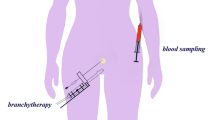Abstract
It remains a challenging problem to simulate the haptic interaction between the fluid and deformable objects due to the inhomogeneity of the deformable object. In this paper, we present a novel position-based haptic interaction method to tackle this problem. On the one hand, according to the inhomogeneity of the deformable object, we calculate the properties of different regions of the deformable object and then evaluate its haptic force so as to make the results more realistic. On the other hand, to preserve more details of haptic feedback forces, we especially incorporate the calculation of buoyancy, pressure, viscous force and elastic force into our framework and design a novel integration scheme for assembling such forces. Moreover, by respecting the influence from fluid viscosity, our method can obtain different haptic force feedback for fluids of different viscosities. Various experiments validated our new method.










Similar content being viewed by others
References
Bargteil AW, Wojtan C, Hodgins JK, Turk G (2007) A finite element method for animating large viscoplastic flow. ACM Trans Gr 26(3):16:1–16:8
Bodin K, Lacoursiere C, Servin M (2012) Constraint fluids. IEEE Trans Vis Comput Gr 18(3):516–526
Cirio G, Marchal M, Hillaire S, Lecuyer A (2010) Six degrees of-freedom haptic interaction with fluids. IEEE Trans Vis Comput Gr 17(11):1714–1727
Cirio G, Marchal M, Otaduy MA, Lecuyer A (2013) Six-oof haptic interaction with fluids, solids, and their transitions. World Haptics Conf 2013:157–162
Dobashi Y, Yamamoto T, Sato M, Hasegawa S, Kato M, Nishita T (2007) A precomputed approach for real-time haptic interaction with fluids. IEEE Comput Gr Appl 27(3):90–92
Ihmsen M, Cornelis J, Solenthaler B, Horvath C, Teschner M (2014) Implicit incompressible SPH. IEEE Trans Vis Comput Gr 20(3):426–435
Irving G, Teran J, Fedkiw R (2004) Invertible finite elements for robust simulation of large deformation. In: Proceedings of ACM Siggraph/Eurographics symposium on computer animation, pp 131–140
Karadogan E, Williams RL (2013) Haptic modules for palpatory diagnosis training of medical students. Virtual Real 17:45–58
Liu G, Zhang Y, Wang D, Townsend WT (2008) Stable haptic interaction using a damping model to implement a realistic tooth-cutting simulation for dental training. Virtual Real 12:99–106
Luciano C, Banerjee PP, DeFanti TA (2009) Hapticsbased virtual reality periodontal training simulator. Virtual Real 13:69–85
Macklin M, Muller M (2013) Position based fluids. ACM Trans Gr 32(3):104:1–104:12
Macklin M, Muller M, Chentanez N, Kim TY (2014) Unified particle physics for real-time applications. ACM Trans Gr 33(4):1–12
Monaghan JJ (2000) SPH without a tensile instability. J Comput Phys 159(2):290–311
Mora J, Lee WS (2008) Real-time 3D fluid interaction with a haptic user interface. In: Proceedings of IEEE symposium on 3D user interfaces, pp 75–81
Muller M, Charypar D, Gross M (2003) Particle-based fluid simulation for interactive applications. In: Proceedings of the ACM SIGGRAPH/Eurographics symposium on Computer animation, pp 154–159
Muller M, Heidelberger B, Hennix M, Ratcliff J (2006) Position based dynamics. In: Proceedings of workshop in virtual reality interactions and physical simulation
Nixon D, Lobb R (2002) A fluid-based soft-object model. IEEE Comput Gr Appl 22(4):68–75
O’Brien JF, Bargteil AW, Hodgins JK (2002) Graphical modeling and animation of ductile fracture. ACM Trans Gr 21(3):291–294
Schechter H, Bridson R (2012) Ghost SPH for animating water. ACM Trans Gr 31(4):61:1–61:8
Solenthaler B, Pajarola R (2009) Predictive-corrective incompressible SPH. ACM Trans Gr 28(3):341–352
Tavakoli M, Patel RV, Moallem M (2006) A haptic interface for computer-integrated endoscopic surgery and training. Virtual Real 9:160–176
Teschner M, Heidelberger B, Muller M, Pomerantes D, Gross MH (2003) Optimized spatial hashing for collision detection of deformable objects. In: Proceedings of VMV, pp 47–54
Violeau D, Leroy A (2015) Optimal time step for incompressible SPH. J Comput Phys 288:119–130
Wang Z, Wang Y (2014) Haptic interaction with fluid based on smooth particles and finite elements. In: Proceedings of international conference on computational science and its applications, pp 808–823
Wicke M, Ritchie D, Klingner BM, Burke S, Shewchuk JR, O’Brien JF (2010) Dynamic local remeshing for elastoplastic simulation. ACM Trans Gr 29(4):157–166
Yang M, Lu J, Safonova A, Kuchenbecker KJ (2009) GPU methods for real-time haptic interaction with 3d fluids. In: Proceedings of IEEE international workshop on haptic audio visual environments and games, pp 24–29
Zhang X, Liu S (2017) SPH haptic interaction with multiple-fluid simulation. Virtual Real 21(4):165–175
Acknowledgements
The study was funded by National Natural Science Foundation of China with Grant Nos. 61672375 and 61170118.
Author information
Authors and Affiliations
Corresponding author
Electronic supplementary material
Below is the link to the electronic supplementary material.
Supplementary material 1 (WMV 5417 kb)
Rights and permissions
About this article
Cite this article
Liu, S., Ma, C. & Feng, G. Haptic rendering for the coupling between fluid and deformable object. Virtual Reality 23, 33–44 (2019). https://doi.org/10.1007/s10055-018-0351-6
Received:
Accepted:
Published:
Issue Date:
DOI: https://doi.org/10.1007/s10055-018-0351-6




